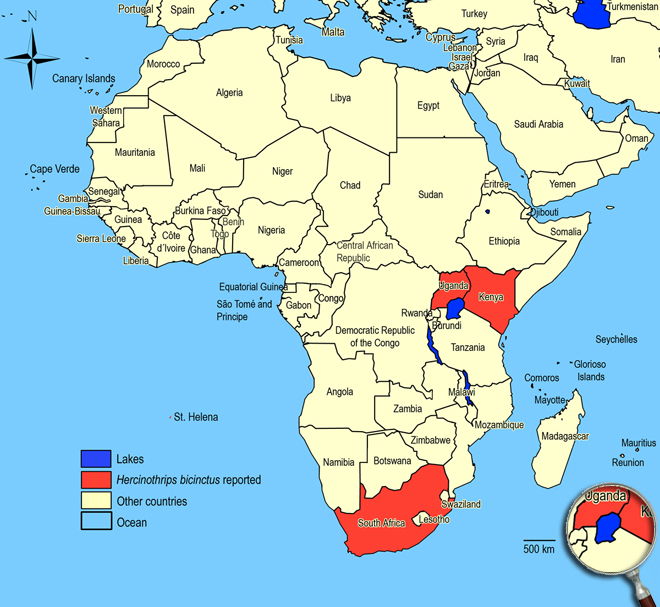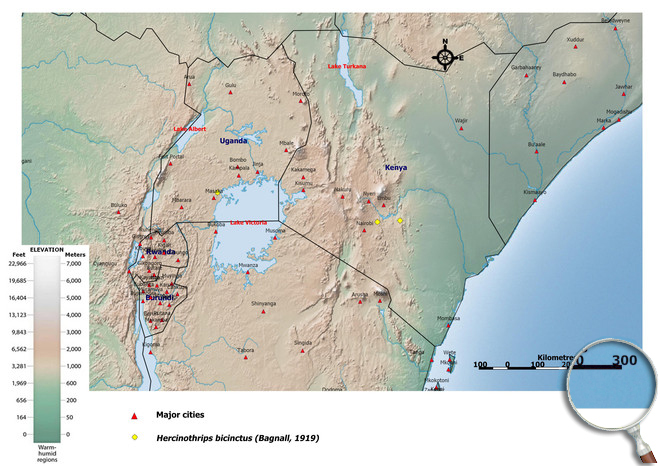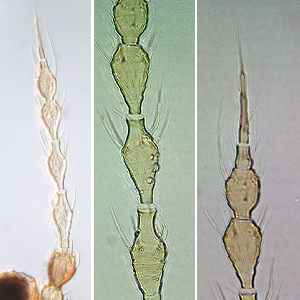Hercinothrips bicinctus (Bagnall, 1919)
Panchaetothripinae, Thripidae, Terebrantia, Thysanoptera
Figures
Fig. 1: 8-segmented antenna, segments III and IV with forked sense cone and segment V, terminal segments V-VIII
Fig. 2: Head dorsal with ocellar triangle
Fig. 3: Head and pronotum
Fig. 4: Meso- and metanotum
Fig. 5: Fore wing and fore wing distal region
Fig. 6: Tergites II and III
Fig. 7: Tergites III-VI
Fig. 8: Tergites VIII and IX
Fig. 9: Tergites IX-XI
Introduction and recognition
Hercinothrips bicinctus causes leaf and fruit damage to a range of crops, including bananas. Both sexes fully winged. Body brown; head yellow sub-medially, also abdominal segments 9 and 10; tarsi and tibiae, antennal segments I and III-VIII yellow; fore wings pale, lightly shaded at base, with 2 short dark brown transverse bands, extensive pale area medially distinctly longer than the pale apex of wing. Antennae 8-segmented; segments III and IV with sense cone forked and extending well beyond apex of segment, VIII more than twice as long as VII (Fig. 1). Head finely reticulate, with cheeks convex, sharply constricted to basal neck (Fig. 2). Pronotum finely reticulate; with several pairs of moderately long discal setae (Fig. 3). Mesonotum not divided medially. Metanotum with weakly defined reticulate triangular area medially; median setae long (Fig. 4); 1 pair of campaniform sensilla present; metafurca elongate and Y-shaped. Mid and hind tarsi 2-segmented. Fore wing first vein close or fused to costal vein; fore wing with complete row of setae on both longitudinal veins; costal cilia longer than setae, posteromarginal cilia wavy (Fig. 5). Tergites reticulate; median tergal setae minute (Fig. 6 and 7); lateral fourth of tergites I-VIII with a posterolateral comb of short wedge-like teeth which are produced into long needles on VIII (Fig. 8); tergite X with longitudinal split almost complete (Fig. 9).
Male lighter than female; with 3 pairs of spine-like setae on tergite IX; sternites III-VII with very small circular glandular area.
Taxonomic identity
Species
Hercinothrips bicinctus (Bagnall, 1919)
Taxonomic history
Caliothrips bifasciipennis Faure, 1962
Hercothrips bicinctus Hood, 1927
Heliothrips bifasciipennis Girault, 1926
Heliothrips bicinctus Bagnall, 1919
Common name
Banana [silvering] thrips
Smilax thrips
Present taxonomic position
Family: Thripidae Stephens, 1829
Subfamily: Panchaetothripinae Bagnall, 1912
Genus: Hercinothrips Bagnall, 1932
Genus description
The genus Hercinothrips Bagnall, 1932
About 10 species recognised in this genus, all originally from Africa, a few are recorded as crop pests and are now widespread around the world. They can be distinguished from each other by differences in the color pattern of the body and the fore wings (Wilson 1975). Unlike the species of most Panchaetothripinae genera, the members of Hercinothrips have 2-segmented tarsi, and both veins of the fore wings bear complete rows of long setae. All of them have 8 antennal segments, antennal segments III and IV with forked sense cone, fore wings banded and with posterior fringe undulated.
Species description
Typical key character states of Hercinothrips bicinctus
Coloration and body sculpture
Surface of head, pronotum and fore legs: with heavy, often polygonally reticulate sculpture
Body color: mainly brown to dark brown
Sculptured reticles on head and pronotum: with no internal markings
Antennae
Number of antennal segments: 8
Form of sense cones on antennal segment III and IV: emergent and forked on segment III and IV
Forked sense cone on antennal segment IV: extending to a point at least a third to base of segment V
Terminal antennal segments: VI-VIII forming a single unit
Head
Cheeks shape: constricted to basal neck
Head - occipital ridge dorsally: absent
Head: not prolonged in front of compound eyes
Ocelli: present
Prothorax
Pronal blotch or internal apodeme: absent
Pronotum shape: broadly rectangular
Pronotum surface: with transverse reticulate sculpture
Mesothorax
Mesonotum: with an incomplete median division
Metathorax
Metanotum with dominant sculptured triangle medially: absent or with weakly defined reticulate triangular area medially
Shape of metathoracic furca: elongate and Y-shaped
Wings
Fore and hind wings: present, more than half as long as abdomen (macropterous)
Fringe cilia arising: from sockets
Fore wing veins: present
Fore- and hind wing surface: covered with microtrichia
Fore wing extreme apex color: pale
Fore wings: alternating bands of dark and light
Apex of fore wing: with prominent terminal setae
Fore wing anterior margin (costal vein): with setae and cilia but cilia longer than setae
Fore wing costal fringe cilia: arising at anterior margin of wing
Fore wing first vein: close to or fused to costal vein
Fore wing first vein setal row: complete, with setae closely and uniformly spaced
Fore wing second vein setal row: complete, setae uniformly spaced
Fore wing shape: mainly parallel sided or margins run continuously towards each other
Fore wing costal setae: not particularly long and dark, lower setal rows present and complete
Fore wing surface: not reticulate
Fringe cilia on posterior margin near apex: distinctly wavy (undulated)
Length of fore wing costal setae at middle of wing: longer than half of median wing width
Shape of fore wing apex: with mainly posterior margin curved to join anterior margin
Legs
Mid and hind tarsi: with two segments
Color of fore tarsi: pale or yellow, sometimes apical shaded or brown
Abdomen
Tergite II: without specialised cuticles laterally
Tergites IV and V median setal pair: shorter than distance between their bases
Tergite VIII to X: without unusually long and stout setae
Tergites: without distinctive tergal sculpture forming a series of arches on the antecostal ridges
Tergite X: not tubular, longitudinally incomplete
Setae on abdominal tergite X: all setae slender

Similar or related species
The species is similar to Hercinothrips femoralis which has antennal segments VI-VIII dark brown, fore wings with a short submedian pale area, when present, no longer than the pale apex of wing, no triangular area medially on metanotum. Whereas Hercinothrips bicinctus possesses antennal segments VI-VIII yellow, fore wings with an extensive pale area medially distinctly longer than the pale apex of wing, and a weakly defined reticulate triangular area medially on metanotum.
Unlike the species of most Panchaetothripinae genera, members of Hercinothrips have 2-segmented tarsi (like in Monilothrips kempi and Panchaetothrips noxius), and complete rows of long setae on both veins of the fore wing (like in Monilothrips kempi and Selenothrips rubrocinctus). Monilothrips kempi differs from species of Hercinothrips in having no reticulate sculpture on head and pronotum except for the collar, no constriction posteriorly on head, but having 2 pairs of elongated pronotal setae and a distinct occipital ridge. Compared to Hercinothrips, Panchaetothrips noxius has a distinct occipital ridge and a pronotum without strong sculpture, the fore wing first vein setal row is incomplete, the second setal row is absent, costal setae on fore wing are about twice as long as wing width, all fore wing setae dark, comb of microtrichia on tergite VIII absent, and tergite X elongate and tubular. In contrast to Hercinothrips, Selenothrips rubrocinctus has a pronotum with transverse striate sculpture, a dominant sculptured triangle medially on metanotum, uniformly dark brown fore wings, costal setae on fore wing which are about twice as long as wing width, and a complete comb of microtrichia on tergite VIII.
Biology
Life history
As with other thrips species the life cycle from egg to adult is dependent on temperature. The tiny eggs are laid just into the plant tissue. The larvae hatch after 7 or 8 days and the larval stages lasts about 10 days after which the second larvae and propupae move down into the soil to pupate. Adults emerge after a further 7 to 10 days Pinese & Piper 1994).
Host plants
Crops: African nightshade, banana, eggplant, potato.
Weeds: Acanthospermum hispidum.
Vector capacity
None identified, but possible mechanical distribution of phytopathogenic fungi and bacteria.
Damage and symptoms
Feeding by these thrips causes silver speckling of green fruit (hence the common name of the insect), particularly on green bananas (Faure 1957). Silvery or brown patches covered with small black spots found on the fruits. The skin of severely infested fruit may crack, and this allows secondary rots to attack the fruit (Hill 1983). The adults and larvae feed also on mature leaves, and the pupae are found on leaves.
Detection and control strategies
Clean cultivation with effective management of weeds such as Acanthospermum hispidum which can harbour Banana thrips could reduce their incidence. Appropriate bunch treatment at the time of bunch pruning with botanicals such as pyrethrum and neem or covering of bunch are useful.
Additional notes
-
Biogeography
Pantropical, widespread in the Old World tropics from Africa, Australia, New Zealand, Europe (originally from Africa and established in the tropics and subtropics where greenhouse plants are grown). Kenya, South Africa (KwaZulu-Natal: Richards Bay, Eshowe, Durban, Ifafa Beach, Port Shepstone; Eastern Cape: Somerset East, Port St. Johns; Western Cape: Knysna, Mossel Bay, Hermanus, Cape Town, Cape Peninsula),
St. Helena, Uganda.
African countries where Hercinothrips bicinctus has been reported

Occurence of Hercinothrips bicinctus in East Africa

Please click here for survey sites of all observed thrips species of Kenya, Tanzania and Uganda.
Click here for locations of Hercinothrips bicinctus in parts of East Africa.

Bibliography
Bagnall RS (1919). Brief descriptions of new Thysanoptera - X. Annals and Magazine of Natural History, Zoology, Botany and Geology. (Serie 9) 4: 253-277
Bagnall RS (1932). Brief descriptions of new Thysanoptera - XVII. Annals and Magazine of Natural History, Zoology, Botany and Geology. (Serie 10) 10: 505-520
Bailey SF (1957). The thrips of California. Part I: Suborder Terebrantia. Bulletin of the California Insect Survey. 4 (5): 143-220
Faure JC (1957). South African Thysanoptera - 6. Journal of the Entomological Society of Southern Africa. 20 (1): 79-105
Hill D (1983). Agricultural insect pests of the tropics and their control, (2nd edition). Cambridge University Press, Cambridge, 746 pp
Hood JD (1927). New neotropical Thysanoptera collected by C. B. Williams. II. Psyche. 34 (6): 230-246
Lewis T (1973). Thrips: their biology, ecology and economic importance. Academic Press Inc., London Ltd., 349 pp
Moritz G (2006). Thripse. Pflanzensaftsaugende Insekten, Bd. 1, (1. Auflage). Westarp, Hohenwarsleben, 384 pp. ISBN-13: 978 3 89432 891 7
Moritz G, Morris DC & Mound LA (2001). ThripsID - Pest thrips of the world. ACIAR and CSIRO Publishing Collingwood, Victoria, Australia, CDROM ISBN 1 86320 296 X
Moritz G, Mound LA, Morris DC & Goldarazena A (2004). Pest thrips of the world - an identification and information system using molecular and microscopical methods. Centre for Biological Information Technology, University of Queensland, Australia, CDROM ISBN 1 86499 781 8
Moritz G, O'Donnell C & Parrella M (2009). Pest thrips of North America. Centre for Biological Information Technology, University of Queensland, Australia, CDROM ISBN-13: 978 1 86499 940 2
Mound LA (1970). Studies on heliothripine Thysanoptera. Proceedings of the Royal Entomological Society of London. 39 (3-4): 41-56
Mound LA & Kibby G (1998). Thysanoptera: An identification guide, (2nd edition). CAB International, Wallingford and New York, 70 pp
Mound LA & Marullo R (1996). The thrips of Central and South America: An introduction (Insecta: Thysanoptera). Memoirs on Entomology, International, Vol. 6. Associated Publishers, Gainsville, 487 pp
Palmer JM (1990). Identification of the common thrips of Tropical Africa (Thysanoptera, Insecta). Tropical Pest Management. 36 (1): 27-49
Pinese B & Piper R (1994). Bananas - insect and mite management. Department of Primary Industries, Brisbane, 77 pp.
Wilson TH (1975). A monograph of the subfamily Panchaetothripinae (Thysanoptera: Thripidae). Memoirs of the American Entomological Institute. 23: 1-354
zur Strassen R (1960). Catalogue of the known species of South African Thysanoptera. Journal of the Entomological Society of Southern Africa. 23 (2): 321-367
zur Strassen R (1969). Neue Angaben zur Thysanopteren-Fauna (Insecta, Thysanoptera) der Kanarischen Inseln. Commentationes Biologicae. 31 (5): 1-74
zur Strassen R (1976). La fauna terrestre de ľile de Sainte-Hélène III - 18. Thysanoptera. Annales de la Musee Royal de ľAfrique Central, Série 8, Sciences Zoologiques. 215: 236-256
zur Strassen R (2003). Die terebranten Thysanopteren Europas und des Mittelmeer-Gebietes. Die Tierwelt Deutschlands und der angrenzenden Meeresteile nach ihren Merkmalen und nach ihrer Lebensweise, 74. Teil. Goecke & Evers, Keltern, Germany, 277 pp
zur Strassen R (2006). Checklist of the Thysanoptera (Insecta) of southern Africa. African Entomology. 14 (1): 63-68
----
Web links
Mound´s Thysanoptera pages
Thysanoptera Checklist
ICIPE Thrips survey sites
UNI Halle & Thrips sites
Thrips of California













